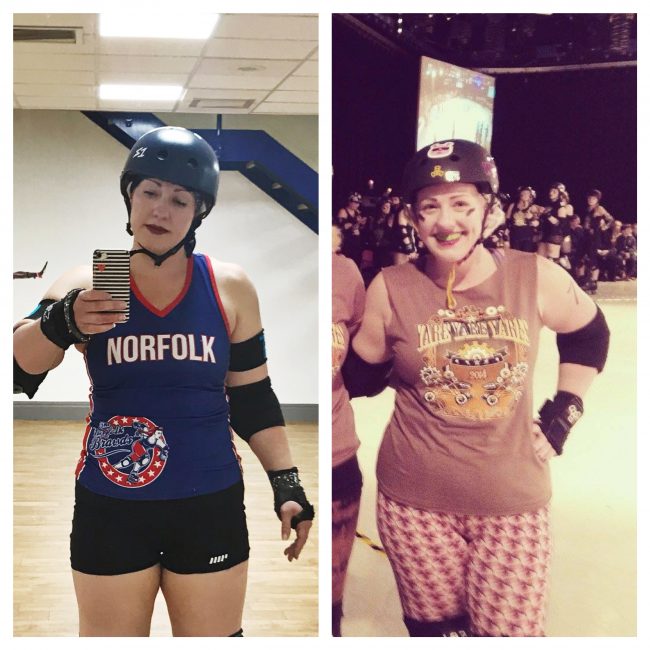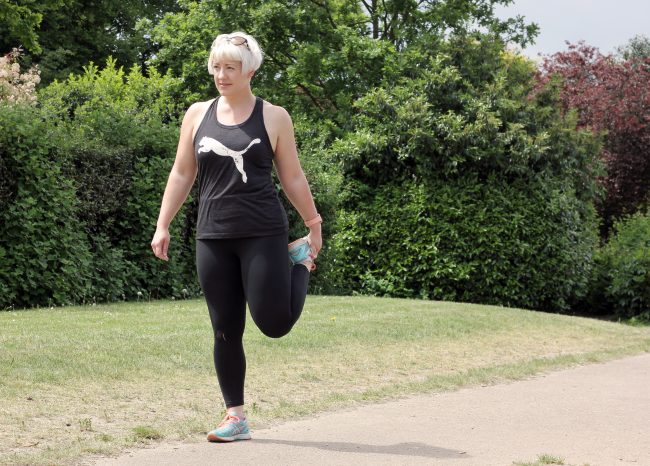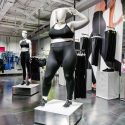It’s been an interesting week in the world of body politics.
I’d been idly pondering a post like this for a while.
Partly based on this article on Girls Gone Strong about the pressure to be “picture perfect” as a Personal Trainer. It made me think about my own feelings about becoming a Personal Trainer and how that makes me feel about my body, spending more time in a gym full of super buff people necking protein shakes.
And partly based on the fact that I walk past a Slimming World advert every day when I walk the Pugs that declares that someone has reached her “dream weight”. I couldn’t help but ponder the ridiculousness of having a “dream weight”. I currently weigh the same as I did 5 years ago, but I’m not the same shape, or size, or level of fitness or strength. Which makes the concept of a “dream weight” look a bit nuts if your goal is aesthetic.

Then, of course, while I was pondering these issues, Nike went and revealed an awesome plus size mannequin in their stores.
That’s awesome, I thought, and then was astonished to find that not everyone thought that was awesome and that there were multiple articles out there berating Nike for normalising fat bodies, and stating that anyone that size must DEFINITELY be pre-diabetic and suffering from all kinds of health problems.
Obesity may be a risk factor for diabetes, but so is inactivity. A diabetic person uses many accoutrements, which helps them in treating diabetes. Many use diabetic socks for men to maximize blood flow to the legs and prevent complications. While a diabetic person’s lack of interest in fitness can be justified due to their condition, but the same cannot be said about a fat person who finds fitness unnecessary. Call me cynical, but getting huffy because a sportswear brand is trying to sell its products to larger women based on “health reasons” doesn’t quite ring true.
I’ve written in the past about the idea of being fat and fit, and my own relationship with my body and exercise. I’ve tried to write about the total disconnect we have between the health of our body, what it can do and what we put into it, the appearance of our body and about actually being honest with ourselves about whether we’re really “fit and fat” or whether we even care about that anyway. Because you don’t have to, you know and you can also care about it more or less at different points in your life.
Then the other day I suddenly wondered, “Who in the hell decided being fat was bad anyway?” and who put the arbitrary numbers in place based on weight?
I started reading up, and the answer, as far as I can tell before it all started giving me a headache, is Insurance Companies. It seems that shortly after WWII insurance companies started to note an increase in death claims amongst their heavier customers. The data of customers heights and weights were recorded and “desirable” height and weight charts produced.
So are we basing our modern idea of what “fat” is on insurance company data from 70 years ago?
Yes and no.
There’s a lot of research that suggests a correlation between excess body fat and a higher risk of certain diseases that you wouldn’t want, unless you are weird. But correlation doesn’t always prove causation.
There are also studies that show that increased physical activity lowers your risk of these diseases regardless of body size, and, of course, other studies that show the opposite.
It seems that no one knows for sure what level of “fat” is bad, and how much that might be cancelled out by other factors like physical activity and cardiovascular fitness, smoking, alcohol consumption and the actual contents of the diet such as red meat, processed foods, sugar and salt.
I still get insanely cross about how difficult the world seems to make it to eat well and stay balanced. We’re bombarded with food advertising, some of it trying to convince us that a Snickers is a health food because it’s a “protein Snickers” (I totally eat these by the way) and sneaking portion sizes past us by selling bumper bags with ONLY 100 CALORIES splashed across the front and for half a bag hidden on the back.
You could eat an unprocessed vegan raw food diet all day and still have a BMI of 35 if you ate enough of it, and similarly having a BMI of 22 because all you ate today is a packet of crisps and a chocolate bar washed down by 20 Marlboro Lights, a bottle of white wine and some detox tea is entirely possible, but no guarantee of health and/or fitness.
So do those who judge others for their body size do so out of fear that they secretly know that their own eating and exercise habits don’t stand scrutiny and that it’s luck, rather than judgement that keeps them out of the diabetes camp themselves, or do they really not understand that a risk factor is just that, a risk factor, not a guarantee of getting a disease.
When I started exercising regularly back in about 2012 I was right at the top of most athletic clothing brands size range at a measly size 12-14. These days I’m in the same size range, but things have moved on and the size ranges of many companies are expanding. Which is fabulous news.

What I really want is to encourage everyone to learn to love to move their bodies, to discover that “fitness” isn’t a destination, it’s how you live your life, that moving your body, getting strong and exercising is about more than aesthetics, it’s about feeling amazing, a sense of accomplishment, and about getting out of your head.
I love that Nike’s plus size mannequins might make a woman feel that she can get out there and run, or box, or go to the gym in the same stylish gym kit that her smaller sisters wear.
My advice, is throw out the scales, ignore dress size labels, and focus honestly on whether you feel good. Do you have energy, do you feel strong and awesome, can you pick things up off the floor without 10 minutes notice (I’m a hard no to that last one right now, but I’ve always had a dodgy back!). In short, do you FEEL GOOD?
If the answer is yes, then awesome, keep doing what you’re doing. If no, then what can you change to feel better? Eat better, move more, reduce stress, drink less, stop smoking, all of these are other health risk factors in your life that you have just as much, if not more, control over than your weight.
No one wants to be unhealthy, but health is a far bigger picture than the size of leggings you buy and it’s great to see big brands like Nike starting to realise that.

Comments
15 responses to “Who Decided Fat Was Bad Anyway?”
I feel very strongly about this I’m considered obese in BMI terms and this week when I went to the docs in.a lot of pain asking for help. whilst the doc did deal with my issue. despite me being near to tears in pain she said well this could be a wake up call. at first I thought what is she talking about and then I realised. despite her telling me what I have is a bit of a mystery but is thought to be viral, she tried to tell me it was a wake up call on my weight.
by the questions she asked she made all sorts of assumptions about me that despite my pain I dispelled, good job I was in pain or I would have let rip! she assumed I had a problem with food, she assumed I drank to excess, ate rubbish, I can go on. she still referred me to slimming world and told me if I actually stuck to it I’d lose weight, the implication being I dont watch what I eat. she then took my vitals and then said I was fit and healthy!!!!
but I’m fat and that’s evil and so I must change. I cannot stand that it seems acceptable that some people are very slim and struggle to gain weight but it is not acceptable to be overweight and struggled to lose weight!
sorry I’m ranting. I beat myself up about my weight and have done all my life, I lose a bit but plateau quickly and then no more. its depressing and then I think why is it depressing. cos society tells me I’m failure because I’m fat.
sorry that’s really long, rant over x
That is awful. Obesity is an issue for the NHS particularly as it contributes to a lot of diseases, but the focus on it has become so blinkered that they can’t see past the number on a page to actually look at peoples lifestyles. I’m really sorry this happened to you.
I can’t believe the Slimming World is where she chose to refer you either! They’re the ones with the Dream Weight poster!
I was going to go as it’s free then I thought, mmm I dunno. Also I had to complete an questionnaire over the phone to a SW representative. They asked how many veg and fruit portions do I eat a day, I said it varies but probably 10, not untrue and she said she had NEVER had someone say 10. Surely if you’re veggie like I am 10 is not a lot, I eat 2 lots of fruit with breakfast so 10 is no problem!
Ha ha! Great!
Yes! Totally agree with everything you’ve said here.
I completed my 5th marathon on crutches at the weekend(Edinburgh Moonwalk) and I’m a size 16. So yep I’ve got lumps and bumps that jiggle but I’m strong af and can walk for 8 hours straight. People who judge me on my size have no idea how amazing my body is!
I do hate having to use the crutches but they help me do something I love. it’s taken 12 years from my accident to manage without sticks in general day to day but anything over half a mile and I need help or the pain becomes unbearable. Still, I would rather be like this and enjoying the hell out of my life than a size 10 obsessively counting calories and worrying how I look
Kirsten x
That’s amazing! well done, what an achievement!
A fantastic post as usual. I have recently taken up running using the help from the couch 2 5K app. At first it was to lose weight because a move, stress and all sorts means I have gained a couple of kilos (and I have a long history of issues with my weight from being technically “obese” all the way to anorexic). Seven weeks in and I haven’t dropped a pound. But through the process I began to realise something. That going from running nothing, to running for almost half an hour feels amazing. I have more energy, I feel more positive. I’ve always wanted to be “a runner” but could never figure out why I wasn’t. Well it was because I didn’t train, do the work and become a runner. It’s taken work and effort and sometimes I don’t want to get out of bed a 5.45 am and run in the heat that is already pushing 25 degress. But I am still going, and now it’s not about the weight, it’s about fitness and emotion and longterm mental and physical wellbeing. I might never lose those those extra kilos, but now I’ve realised I don’t need to. I didn’t need to change my shape, just my mind.
YES!! This is what I finally found when I started running, that’s amazing! Keep it up 😀
I really love this blog and I completely agree. I’m considered obese and I’m definitely heavy, I’ve struggled massively over the years to lose weight despite having a good diet and being active. I’m stronger, fitter and heavier than I’ve ever been. Due to some of the medication I have to take weight loss is a huge issue… So I recently decided fuck that, if I can’t be skinny I will be strong and I’m happy with that, at least now I might be able to find some Leggings that actually fit.
Yes! When you focus entirely on weight it’s so much harder, and so pointless and meaningless too!
Totally agree! I consider myself small and find it ridiculous that I wear L or XL in sports wear – like society expects people to exercise to lose weight but if they are bigger they can’t buy any clothes to exercise in?! My main motivation to exercise is a bad back which stiffens up painfully if i don’t, and mental health issues which don’t allow me to sleep if I don’t exercise. We should focus on whether people are healthy, physically and mentally, and have energy to do things!
By the way I really doubted to post because I worried my view was not valid as someone who is not fat, but I wanted to support your post as I think it’s really important to spread these positive messages!
Thank you! Well, I wrote it, and I don’t consider myself fat either, but apparently, my BMI makes me borderline obese, so hmmmm.
Great insight!
Thank you
http://www.michellereed.co.uk
Well written hun.
… [Trackback]
[…] Informations on that Topic: lipsticklettucelycra.co.uk/blog/2019/06/12/why-is-fat-bad/ […]